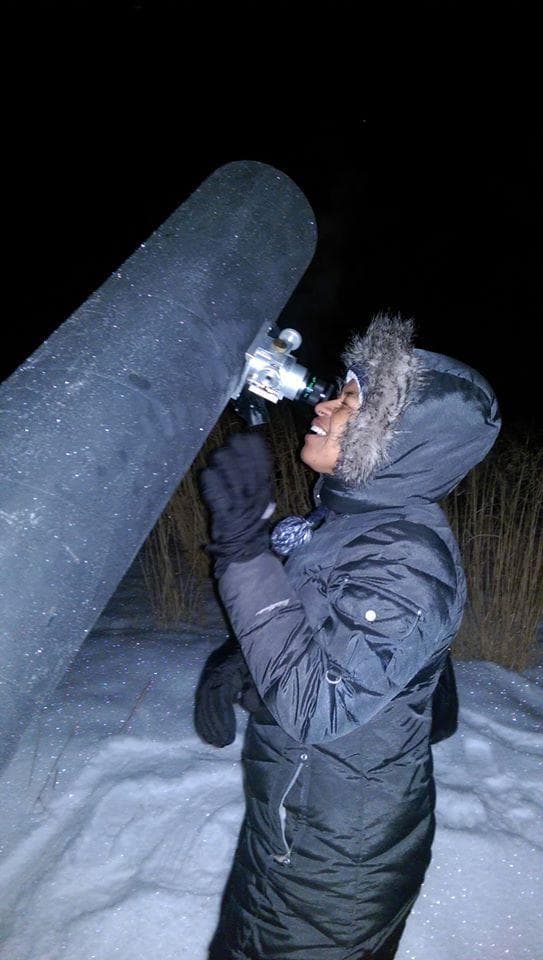
with David Fuller

Tips for astronomy observing in cold weather
've loved astronomy ever since I was about 8 or 9 years old. I can recall my 4th grade teacher telling our class about a meteor shower that would be visible, and begging my parents to let me watch it.
But I've been camping for far longer; my parents took me to many a campground in and around New England when I was just a baby, and I can recall many trips we took, both with their pop-up trailer and then tent camping sometimes with my dad.
I am grateful for those experiences; they've made transitioning into doing camping with my family much more fun. And I've discovered that the more I get out there and do astronomy, that camping shares many things with star gazing.
Star parties
There used to be just a few major star parties in the United States; now there many dozens of star parties that attract 25 or more amateur astronomers. There are countless others that are smaller, less organized affairs, where a few hardy folks travel to a dark sky site, set up a few telescopes, and enjoy the pristine - or at least darker-than-home - night skies that a trip away from civilization affords.
We can add to this the thousands of outreach events that are either well-organized, pre-planned events, or the serendipitous ones where one or a few amateurs set up telescopes in a busy location on a clear night to share the planets, Moon and other bright objects with passers-by.
But all of this - large or small, planned or unplanned - require an important component: Proper clothing!
Dress for success
The more I have gotten back into camping, the more I have realized that my clothing has been ill-suited for much of the astronomy observing I've done. For one thing, as anyone who's been out on a night with a high dew point knows, things can get VERY WET even under a perfectly clear sky.
Humidity in the air can condense on your telescope, your seat/chair, your eyepieces, lenses.. pretty much anywhere. And to top that off, your body - and the Earth - are releasing heat directly up and out into space. Oh sure, the atmosphere slows that down a bit, but you're not receiving warmth from anywhere except what you create!
So it is important to keep that warmth near and dear to yourself, in order to stay warm. Even summer nights can feel surprisingly cold.
One thing I often do is plan to dress with at least one extra layer above and beyond what I would wear for the same conditions if it were daytime. Not only is there no sunlight and my body is releasing heat into the solar system, but for astronomy, the goal is to sit as still as possible at the eyepiece much of the time. So your body is creating even less heat, because you're not creating any energy to warm yourself up!
What to wear?
I've been reading a lot about camping and backpacking/hiking lately. And there are a few pretty consistent things to keep in mind:
1) Cotton is rotten. NO cotton clothing, especially the layers next to your skin! So no socks, thermal underwear or t-shirts made from cotton; once it gets wet, it stays wet for a long time. And wet in the cold makes for much colder feeling skin, and a reduced body temperature. Hikers say, "Cotton is rotten" - there's a good reason. You can actually get hypothermia pretty easily if you sweat with cotton on. Personally, my feet tend to sweat when I try to keep them warm in good boots, so cotton socks just make my feet cold, which in turn makes me miserable. What do to then?
2) Wear wool. Too scratchy you say? Look for merino wool. Not only does it keep you warm even when wet, it wicks water away from the skin, and has smaller fibers which are softer. While it can cost more than synthetic materials, it is often worth the extra money spent to get it. Oh, and watch for "Wool socks" that are actually blends with low wool content. I find my feet like it best when the wool content is 75% or higher. Lower than that, and sweaty feet = cold and wet.
3) Try synthetics. I just go for wool socks, as there are some good options to wear for both base and insulation layers such as polypropylene or polyester. You know those fleece pajamas or pullover sweatshirts? Those are usually polyester. And polypropylene thermal underwear fits close to the skin, and wicks away water, plus it dries quickly.
4) Wear layers. Often one heavy coat isn't as effective as several layers. When it is really cold out (think 0F to 10F), I wear thermal underwear, pants, AND sweatpants over those. Upper body consists of thermal underwear tops, thin microfleece layer, fleece jacket, and THEN a heavy coat. I use a balaclava on my head, plus the hood from the coat goes up on my head.
5) Bring the heat! Don't be afraid to add some artificial heat. Toe warmers and hand warmers can be found in camping and hunting sections of many retailers. These small packs add a bit of warmth that can either be stuck on the bottom of your socks to keep your feet warm, or tossed inside your coat pocket to grab with your gloved/mitten-ed hands to warm up icy fingers. And the bonus? Wet or frosty eyepieces will stay warm and be less susceptible to dew (or have dew removed) when the eyepieces are kept in your pocket with the hand warmers.
Final thoughts
There's lots of other ways to stay warm while observing, but those are a few tips I've learned along the way as I've studied up to be warmer when camping, or have used for a while already as a 'cold-weather observer.'
Remember, the nights may be longer, but the gems of those cold winter nights are only observed in the evening skies during the months of December through March. Otherwise you have to get up very early or stay really late in other months to catch them.
Of course, if you're going camping... well, you can see those then too, which extends your observing time frames! So get out there and observe even when it's cold - now you have a few tips on how to stay warmer while you do observe in winter.
